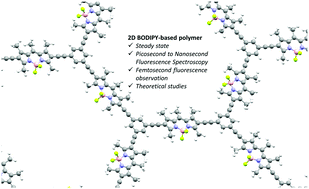Optical characterization of a two-dimensional BODIPY-based polymer material and its related chromophores†
Abstract
We report on optical studies of a boron-dipyrromethene (BODIPY) based conjugated microporous polymer, CMPBDP, a promising material for application in photonic devices, and those of two related model dyes (MD1 and MD2). We used time-resolved fluorescence spectroscopy and theoretical calculations to elucidate the photobehavior of the three material systems. Because of their extended π-conjugation framework, the more intense band in the absorption spectra shows a large bathochromic shift (1581, 1969 and 1158 cm−1, respectively) when compared to that of the unsubstituted BODIPY. Furthermore, the Stokes shift of the main emission bands of MD1 and MD2 depends on the solvent polarity. Both absorption and emission bands of MD2 and CMPBDP suggest the presence of two different species in the S0 and S1 states. The time-resolved fluorescence results show that the initially populated S1 state gives rise to intramolecular charge transfer (ICT) and twisted intramolecular charge transfer (TICT) states within ∼0.3 ps and 2–13 ps, respectively. The ICT structures decay in 0.1–1 ns, while the TICT structures decay in 3–5 ns. The theoretical calculations suggest that for MD1 the electron charge density shifts from the ethynylbenzene moiety to the BODIPY core, while for MD2 it moves in the opposite direction. Our findings depict the complex photodynamics of these BODIPY-based dyes and polymer. They could be used in the design of other molecular systems having the same family members as the central chromophore for photonic applications.

- This article is part of the themed collection: Photonics


 Please wait while we load your content...
Please wait while we load your content...